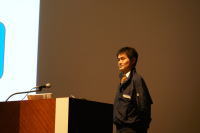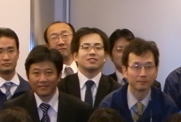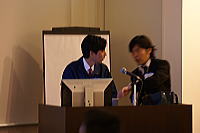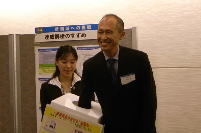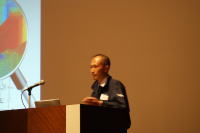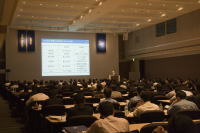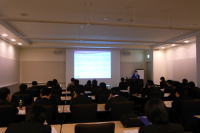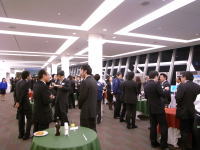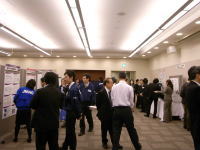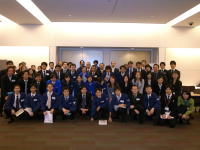Overview
| Organizer |
JRI Solutions |
| Dates |
Wednesday, December 10 – Thursday, December 11, 2008 |
| Venue |
Tokyo Conference Center – Shinagawa
AREA Shinagawa 1-9-36 Konan, Minato-ku, Tokyo
TEL: 03-6717-7000
https://www.tokyo-cc.co.jp/eng/index.html
|
| Expected number of participants |
Approximately 300 |
Program
Wednesday, December 10 / Thursday, December 11
* The contents of the program may be subject to change without notice.
Wednesday, December 10
| 9:30 |
Registration |
| 10:00 |
Opening Remarks
Mr.Toshihiro Hayashi, JRI Solutions |
|
General Session |
| 10:05 |
The history of JMAG
Dr.Takashi Yamada , JRI Solutions |
| 10:25 |
[Keynote Speech]
Numerical Magnetic Field Analysis in Electric Performance Calculation in Large Rotating Machines.
Dr.Kazumasa Ide , Hitachi LTD.
|
|
Motor Session |
| 11:10 |
Customized Development of Automotive Motor System using JMAG-Studio
Mr.Ryoma Matsuo , PUES Corporation |
| 11:40 |
Break (Lunch) |
| 13:30 |
modeFRONTIER as a Strategic Tool for Improving Electromagnetic CAE and Supporting Decision Making
Dr.Yasushi Fujishima , CD-adapco JAPAN Co.,LTD. |
| 14:00 |
Electromagnetic Field Analysis on Giant Magnetostrictive Actuator by using JMAG
Ph.D.Hisashi Yajima , SMC Corporation |
| 14:30 |
Break |
|
Induction heating session |
| 14:40 |
Analysis of an induction-heating fusing unit using JMAG
Mr.Tetsuya Kagawa , KONICA MINOLTA BUSINESS TECHNOLOGIES, INC. |
| 15:10 |
Finite Element Analysis of a Steering Rack Shaft Subjected to the High-Frequency Induction Hardening Process
Mr.Manabu Fukumoto , Sumitomo Metal Industries, Ltd. |
| 15:40 |
Coffee Break |
|
Expanding the Use of JMAG in a Company |
| 17:00 |
Evaluation of eddy current characteristic for applied high frequency voltage to the giant magnetrostrictive material.
Mr.Masayuki Sugasawa , Sony EMCS Corporation |
| 17:30 |
Introduction of the Use of JMAG as CAE among Our Users
Mr.Yusaku Suzuki , JRI Solutions |
| 18:15 |
Banquet |
Thursday, December 11
| 8:30 |
Registration |
|
Fast Large-Scale Analysis Session |
| 9:00 |
Speeding Up JMAG’s Solver for Large Scale Problems.
Mr.Kazuki Semba , JRI Solutions |
| 9:15 |
Technology for accelerating electromagnetic field analyses.
Dr.Takeshi Iwashita , Kyoto University |
| 9:45 |
Scaling ICCG Performance in Multicore: The Current and Future Perspective.
Dr.Shigeki Gunji , Sumisho Computer Systems Corporation |
| 10:15 |
Coffee Break |
|
Transformer session |
| 10:25 |
Estimation of Dispersion in Inductance in Small, Low Profile Transformers.
Mr.Masahiro Shima , COSEL CO., LTD. |
| 10:55 |
Effective Use of JMAG Software for Analyzing Switching Transformers
Mr.Hideo Matsumoto , TABUCHI ELECTRIC CO.,LTD. |
| 11:25 |
Efficiency improvement of non-contact power supply systems
Mr.Hiroyasu Tomita , MURATA MACHINERY,LTD. |
| 11:55 |
Break (Lunch) |
|
Educational Session |
| 13:45 |
Supervision for students in the electrical machinery using JMAG.
Dr.Kenji Nakamura , Tohoku University |
| 14:15 |
Practice work of JMAG by e-learning.
Dr.Edmund Soji Otabe , Kyushu Institute of Technology |
|
Motor Session |
| 14:45 |
Comparison of IPM and SPM by experimental and analysis results.
Dr.Kan Akatsu , Tokyo University of Agriculture and Technology |
| 15:15 |
Coffee Break |
| 16:45 |
Recent developments and future plan for JMAG
Dr.Takashi Yamada , JRI Solutions. |
| 17:30 |
Closing Remarks |
*The product and service names contained herein are the trademarks or registered trademarks of their respective owners.
icon-user Dr.Kazumasa Ide
icon-building Hitachi LTD.
The design technologies of the large capacity rotating machines have been developed by progress of the analysis oriented R&D, due to difficulty of trial manufacture. The electrical properties have been analyzed by not only using the numerical electromagnetic field calculation but also using the cooperation with concentrated magnetic circuit model, dq-axis equation and so on. In the presentation, the present analysis technologies will be introduced with consideration of historical and technical features of the large capacity machines.
icon-user Dr.Yasushi Fujishima
icon-building CD-adapco JAPAN Co.,LTD.
Electromagnetic CAE process that requires a number of trials by changing design parameters such as sensitivity analysis, data fitting, and design optimization, spends mostly on the series of unessential tasks for design engineers. It contains changing geometry parameters, mesh generation, building analysis model and so on. These should be automated without human intervention to improve CAE process for design engineers. In this session, the automated procedure of electromagnetic CAE will be introduced by showing several application example to describe the merits of CAE process automation. Furthermore, modeFRONTIER also has various post-processing functionsthat support decision making for design engineers. The availability of this functions and effectiveness will be also described.
icon-user Ph.D.Hisashi Yajima
icon-building SMC Corporation
The giant magnetostrictive material is electromechanical transformation one with large magnetpstriction and electro-mechanical coupling factor. We developed the actuator by it; Giant Magnetostrictive Actuator. This paper describes the magnetic field analysis on the actuator by using the finaite element method.
icon-user Mr.Manabu Fukumoto
icon-building Sumitomo Metal Industries, Ltd.
The main purpose of this work is to develop a simulation technique to predict the deflection after the induction resistance heating process, and to utilize it to choose an appropriate process condition before manufacturing. In our simulation model, transient heat generation by ohmic heating and induction heating are calculated using Abaqus with coarse FE mesh and JMAG with fine FE mesh, respectively. Then obtained total heat is used as an input to simulate mechanical response on Abaqus again. Our numerical results, such as temperature histories and residual deflections, show good agreement with the measurements. In addition, the dual- frequency induction heating process is examined numerically.
icon-user Mr.Masayuki Sugasawa
icon-building Sony EMCS Corporation
The giant magnetostrictive material(GMM) has some characteristics of very large strain of more than 1000 ppm, high energy density, and high responsibility. So it is expected to be used for fine positioning device or braking system, and so on. Micro actuator using this equipped with iron yoke and winding coil, therefore, has advantages over PZT type, in simple low voltage driving, high robustness and wide temperature operation range. This paper describes the performance of some divided elements improved the loss of eddy current for applied high frequency voltage to the GMM. The eddy current problem occurred in high frequency driving will be reduced with the size. Quantitative analysis of high frequency dynamic power loss in GMM is calculated by finite element method. Especially divided element counts are depend on skin effect. The calculated results based on the theory shows theeffect of dividing the element of GMM.
icon-user Mr.Yusaku Suzuki
icon-building JSOL Corp.
As the magnetic field analysis CAE is widely used, the purpose and application of CAE become more diversified. Fortunately, I had opportunities to hear from our users about the use of CAE for their products, and also their history of using CAE. In this presentation, I will introduce the services we provide along with the CAE experience of our users. I hope to assist you in your approach to CAE and your vision for the future products.
icon-user Mr.Kazuki Semba
icon-building JSOL Corp.
The calculation speed is the key factor in addressing large-scale electromagnetic field problems. This presentation will discuss the results of speeding up JMAG’s solver by SMP parallel calculation and the enhancement of algorithms using specific examples.
The current attempts to develop a faster solver will also be presented.
icon-user Dr.Takeshi Iwashita
icon-building Kyoto University
Currently, computational environments on which electromagnetic field analyses are performed move to parallel computers based on multi-core processors. I discuss whether these multi-core processors have possibility of accelerating the electromagnetic field analysis. Furthermore, in the context of FEM analyses, I introduce some new techniques for fast linear solvers. The examples of the electromagnetic field analyses using a multigrid method and IDR(s) method are shown. Finally, I give a brief comment on further acceleration of electromagnetic field analysis in future.
icon-user Dr.Shigeki Gunji
icon-building Sumisho Computer Systems Corporation
Efficient utilization of emerging multicore systems remains one of the most challenging questions in several decades. In this talk, I present a brief architectural description of several multicore systems followed by a detailed JMAG scalability analysis on them. Some benchmark results of up-to-date and upcoming multicore systems are also included.
icon-user Mr.Masahiro Shima
icon-building COSEL CO., LTD.
With the increased trend for the miniaturization of DC/DC converters, small transformers are commonly required as they directly affect the product form. To make a transformer smaller and thinner, it is essential to reduce the size of the core. However, errors in the shape of the ferrite cores that occur in the course of processing cause their properties to vary from one another. The uniform, stable properties for the ferrite cores can be achieved by estimating the inductance based on the dispersion of the core measurements, and reducing it. In this study, a transformer with the excitation winding near the gap was used to investigate the dispersion in inductance, taking into the account the current distribution in the winding, which is caused by leakage flux.
icon-user Mr.Hideo Matsumoto
icon-building TABUCHI ELECTRIC CO.,LTD.
High-frequency switching transformers, since they are compact and capable of handling greater capacity, are expected to be used in a variety of products for multiple purposes. Optimizing the design of switching transformers requires the sophisticated magnetic field analysis, thermal analysis, and structural analysis. We present the analysis examples of switching transformers regarding the following most required specification, and provide solutions.
1. Staircase-shape L-I characteristics of a switching transformer with a staircase-type gap
2. Thermal stress caused by high or low temperature due to the material of the spacer of a switching transformer
icon-user Mr.Hiroyasu Tomita
icon-building MURATA MACHINERY,LTD.
A non-contact power supply system (NCPS) is a power device which, unlike a trolley, generates electrical power using a magnetic coupling. It is mainly used for the devices for which eco-friendliness is an important factor such as semiconductor overhead transfer systems (OHT) and liquid crystal panel transfer systems. Our company analyzes the secondly power receiving core of NCPS for more efficient design of magnetic circuits. I will describe the properties of a secondly power receiving core and the related issues obtained from the analysis run with JMAG-Studio and JMAG-ELii.
icon-user Dr.Kenji Nakamura
icon-building Tohoku University
In Ichinokura and Nakamura Laboratory of Tohoku University, a general purpose electromagnetic field analysis software JMAG has been introduced from 2003. We use JMAG to design and analyze various inductors and rotating machinery, and also to verify Reluctance Network Analysis (RNA) which is our original analysis method. In this presentation, I will describe the supervision for students in the electrical machinery using JMAG referring to examples of success and failure.
icon-user Dr.Edmund Soji Otabe
icon-building Kyushu Institute of Technology
Learning by using PC is more and more common even in University as well as high school. JMAG is known as specialized software and difficult to learn. Therefore, practice of JMAG by e-learning is considered to be very effective. In this presentation, e-learning in University is introduced and the example of e-learning system for JMAG is presented. Many students could learn how to use JMAG by themselves, and they could solve some practices. Hence, it is very useful to use e-learning system for learning specialized software such as JMAG.
icon-user Dr.Kan Akatsu
icon-building Tokyo University of Agriculture and Technology
Output characteristics comparison result of IPM and SPM by using experimental and analysis results are reported. Both machine used a same stator and only rotor construction were changed. Iron loss estimation method and measurement result are especially discussed, the accuracy of the analysis results are also discussed. Adding that, the difference between both results including challenging works are reported.
Report
Thank You Notes from the Steering Committee
The JMAG Users Conference 2008 was a huge success, attended by a great number of participants. We had opportunities to exchange information, ideas, and experiences with participants through the presentations, seminar sessions, poster sessions, and evening reception.
We are now pleased to announce that the JMAG Users Conference 2009 will be held in Kyoto. You will be hearing from us about the conference for the months ahead.
If you have any questions and comments about the conference, please contact to our staff at the Secretarial Division.
(Engineering Technology Division: Suzuki)
We would like to express our sincere appreciation to all participants in the Users Conference 2008. This year, there are a broad range of the presentations, seminar sessions and poster sessions. In addition, there were prize drawings during the evening reception. (Congratulations to all the winners!) We hope that these events had met your expectations.
We look forward to seeing you at the JMAG Users Conference next year.
(Sales Division: Morinaga)
Thank you for participating in the JMAG Users Conference 2008.
Though two days seemed to have past very quickly, I had a strong impression that participants were intently exchanging opinions. Unfortunately, I did not have an opportunity to talk to participants directly about the handouts and exhibits, as well as the evening reception. If you have any questions and comments, please let us know. We have already started preparing for the next conference, and look forward to seeing you again in Kyoto.
(Planning Division: Sugata, on the right)
The JMAG Users Conference 2008 was a resounding success. We are very pleased to have you all. Being a staff at the Secretarial Division, I was fortunate to interact with speakers, exhibitors, and participants.
For the conference 2009, we hope to provide better assistance for your needs and enhance an evening reception. Also, we do our best to meet all participants’ expectations.
We look forward to seeing you all in next year’s conference in Kyoto.
(Secretarial Division: Igarashi, on the left)
The next JMAG Users Conference will be held from 10 to 11 December 2009 at Kyoto International Conference Center in Kyoto.
We hope you can join us.
